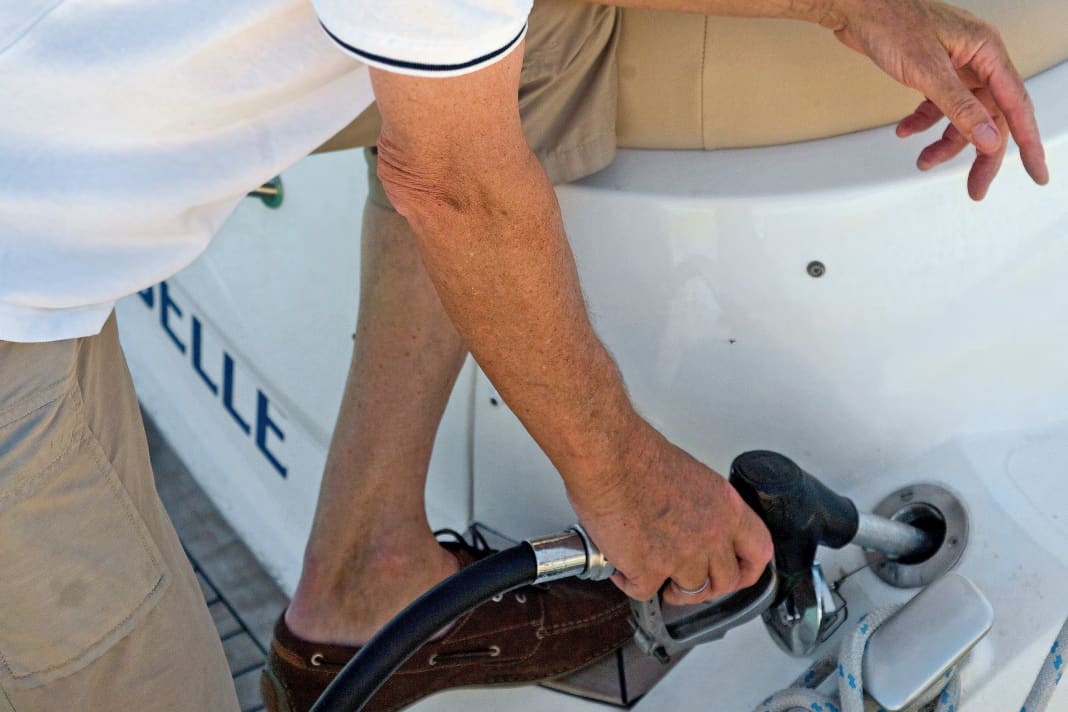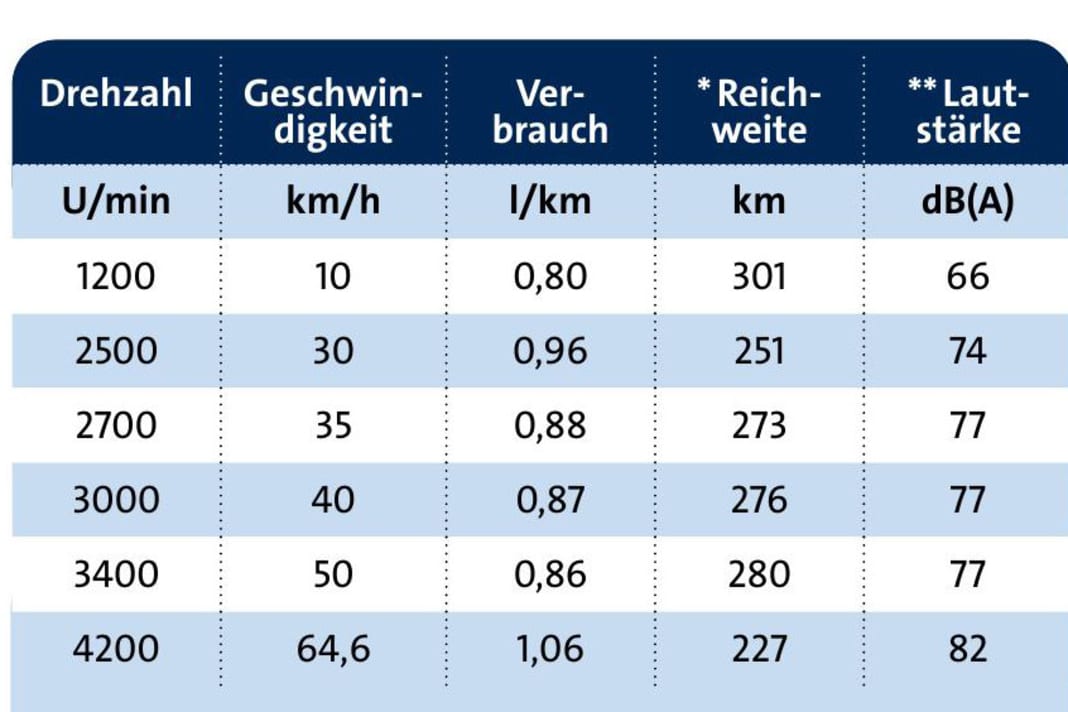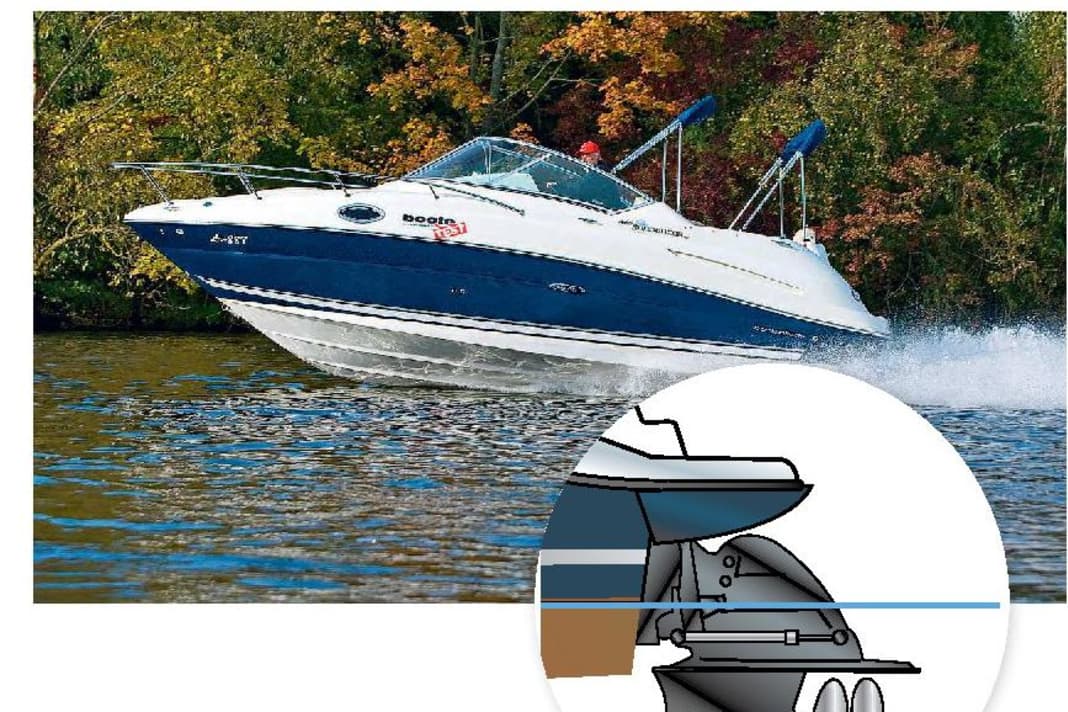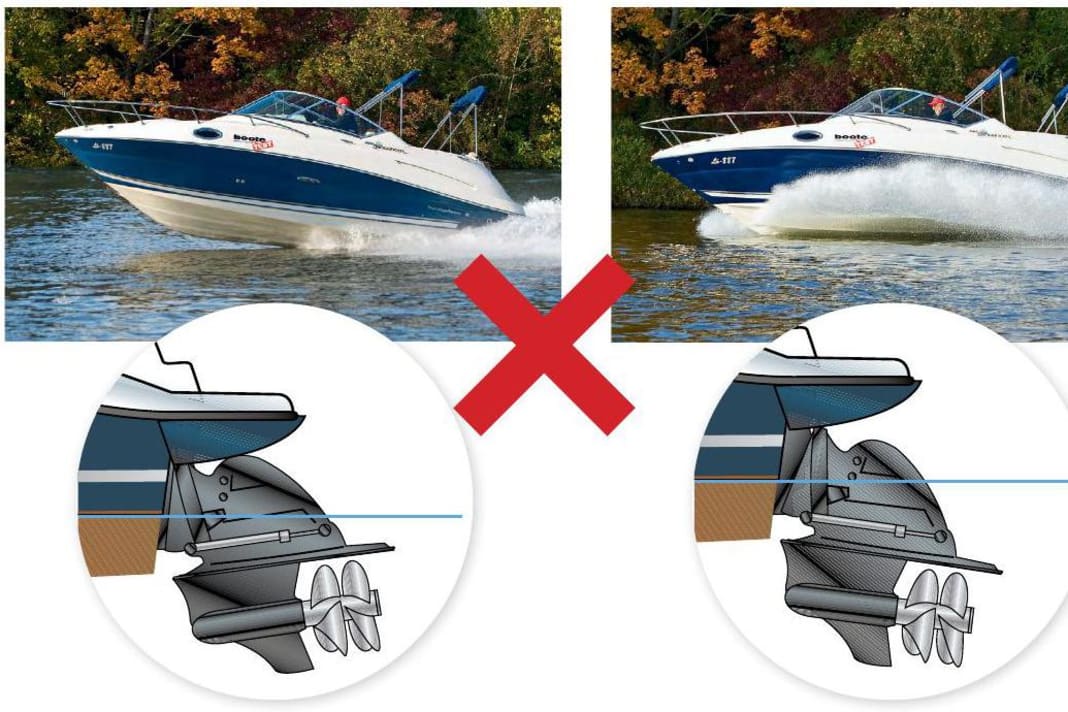Boating practice: Economy measures on board - how to save fuel in 8 steps






And if petrol costs three marks ten, who cares, it'll be fine." It would be nice! The lyrics of Markus' song are 40 years old and the fuel price sung about in it is a real bargain today. In other words, to stick with the lyrics, the petrol station attendant is no longer our best friend. The average boater can hardly do anything about the high prices, the only thing that helps is to save petrol. And you don't even need a high school diploma or a degree to do that. It's often the little things that make life (or survival) as a motorboater easier. We have summarised the ten most important and simplest tips for you on the following pages.
A clean underwater hull
Because the drag coefficient in the water can double in extreme cases, algae growth, mussels and barnacles act like an applied handbrake. As a result, gliders mutate into displacers even at full throttle. Even a small amount of growth on the propeller can cause a 30% loss of thrust. The fact is: mussels & co. slow you down and cost fuel. That's why the underwater hull, propeller shaft, shaft bracket, rudder blade and sterndrive should always be smooth and clean. The most environmentally friendly way to achieve this is frequent mechanical cleaning with a high-pressure cleaner and brush, and the most convenient way is to apply a coat of antifouling. The paint manufacturers and their dealers will tell you which antifouling is the right one for your area and how it should be applied in well-designed brochures, at the sales counter and on the Internet.

The right propeller
Three, four or five wings, Bronze, plastic, aluminium or stainless steel, large diameter or high pitch? Once you have found the right design and material for your propeller in consultation with the shipyard, dealer and engine manufacturer, you need to tailor it to your boat like a made-to-measure suit. The "cut sheet" is characterised by the boat's character, engine performance and area of use. The "cut" is best achieved with the help of a professional rev counter during test drives. The boat should be equipped and loaded in the same way as it will normally be used. The best performance is achieved when the full load speed is at the upper end of the speed range specified by the manufacturer for the engine.
If it is significantly lower, the propeller is too large. This would be like starting a car in third gear on a hill. If the engine is operated at higher than recommended speeds, a loss of power and premature wear are inevitable. A helpful rule of thumb for propeller tuning says that one inch more diameter or pitch reduces the full load speed by around 200 to 300 rpm. If you choose a smaller diameter or pitch (1 inch less), the achievable full-load speed increases by the aforementioned value. The fact is that an incorrect propeller increases fuel consumption and can lead to total engine failure in the long term.
Propeller tip
- The best driving performance is achieved when the full load speed is at the upper end of the speed range specified by the manufacturer for the engine.
- One inch more diameter or pitch reduces the full load speed by around 200 to 300 rpm.
- An incorrect propeller increases fuel consumption and can lead to a total loss in the long term.





The right trim to save fuel
The position of the boat has a massive influence on handling behaviour and fuel consumption. In addition to the right propeller, the right trim is a very important factor when it comes to saving fuel. The designer does the most important work here. He places the engine, tank and fittings in the right position and determines the (design) waterline based on the calculated weight. The owner then "only" has to make sure that his boat floats on the pre-drawn line in the water.
Displacers must therefore lie horizontally on the water in the rest position, whereby the lower edge of the water pass or the upper edge of the underwater coating should be clearly visible.
Semi-gliders are constantly travelling uphill. The bow usually points steeply upwards. Speed and dynamic lift are not sufficient to overcome the wave resistance. This may be due to the hull design and/or a lack of engine power and increases fuel consumption. Trimming exercises with weight shifts are usually unsuccessful.
Read also about boat trim:
For gliders that overcome their bow wave when travelling and glide on the water surface, trim at rest is of secondary importance. Their handicap lies in the transition phase from displacement to planing and their sensitive reactions to weight shifts. Because constant changes of position are often not enough and passenger jogging is not a permanent solution, engine manufacturers have invented power trim. This allows outboards and sterndrives to be raised and lowered electro-hydraulically while travelling. If the stern of the boat is pushed far down and the bow is pointing skywards, the outboard or sterndrive is tilted too far (too high). A short press on the down side of the trim switch usually provides an immediate remedy. If the stern rises and the bow is low in the water, the outboard or sterndrive must be raised by pressing the up side of the switch. In the correct trim position or floating position, the boat lies almost parallel on the water (front raised by 2° to 4°). A practical tip: Once planing speed has been reached after the transition phase, during which the outboard motor or sterndrive should be lowered completely, raise the motor or sterndrive as far as the rpm and speed increase. A further recognisable feature: when trimmed correctly, the point at which the spray water deflected to the side by the chine becomes clearly visible moves far aft. If the engine or sterndrive and therefore the boat are not lifted far enough, the higher frictional resistance will reduce speed and rpm. In other words, you will be travelling slower and less economically. It should also be mentioned that owners of small outboard motors have to rely on manual operation to find the correct trim position for their motor. For this purpose, there are three or more holes in the bracket, the motor mount on the transom, through which a trim bolt is inserted to hold the motor in the selected position relative to the transom.
Adjustable (hydraulic or electric) trim tabs are more than just practical aids. On a boat whose engine power tends to be at the lower limit, trim tabs can shorten the transition from displacement to planing speed or often make it possible in the first place. In addition, trim tabs can reduce the lower limit for planing. In plain language: the boat enters the displacement phase later with trim tabs than without. In practice, the "braked fall" leads to a more economical driving style. In short, you save fuel. The crux of the matter is that the dynamic lift only makes trim tabs effective at speeds above 15 knots. For all those who now want to tick off the subject of trimming as "I don't understand anyway", it should be said that engine manufacturers and accessory dealers now offer various automatic trim systems.
Trim tabs
- The trim tab in the upper illustration is correct, the one in the lower illustration is clearly too low. Flaps that are set too low make the boat slow and difficult to steer.





Power trim practice
CORRECT
Optimal: Ideally trimmed, the Sea Ray 245 is characterised by course and lateral stability. The engine power is completely converted into thrust, saving up to 7 % fuel at full load.



WRONG
Too high: When fully trimmed, the hull is lifted far out of the water. The Sea Ray reaches maximum speed, but constantly bobs up and down with the bow and sets in noticeably harder in rough water.
Too deep: The Z-drive is trimmed too far. As a result, the bow is pushed deep into the water. The boat runs less stable, slows down and consequently achieves the worst consumption values.



Reduce weight
Do I really need all this on board? It is clear that you should never skimp on safety equipment (life jackets, fire extinguishers, etc.). However, you can think about whether the water tank always needs to be full to the brim and whether the board, the dinghy and the licence-free outboard motor for the little ones can stay ashore on a weekend trip around the corner. The fact is, every extra kilo costs fuel. And that adds up. Why don't you have some fun and weigh everything you have on board in the spring? Let's be honest, you can safely leave the club blazer and the little black dress in the wardrobe. Right? Tinned food, beer and water crates are heavyweights, which is why the question almost inevitably arises: How much of it do I really need on board if I'm heading for a harbour every day? If the boat becomes "lopsided" due to the load, trim tabs can often solve the problem. On the subject of the dinghy: If it is towed behind on the line, it acts like a drag anchor, apart from being a disruptive factor during harbour manoeuvres. This means that speed decreases significantly and fuel consumption increases rapidly. Davits, in which the boat is suspended, are better.



Aerodynamics
Put simply, aerodynamics describes the behaviour of bodies in the air. There are boatbuilding projects that use the airstream to lift the boat, i.e. to make it lighter and thus save fuel with the reduced displacement. A topic for "clever minds"! The average boater is perhaps more interested in what happens when he goes for a drive with his convertible top, which is anything but windy. We tried it out in practice on a 66 km/h Sea Ray Sundancer 245. The result: although the convertible is loud (plus 7 dB/A at full throttle), it has no effect on fuel consumption.
Convertible top



The motor
Engine compartment temperature
Engines like it cold. The colder and therefore denser the air surrounding the engine, the more air is drawn in or charged and the greater the engine power. For this reason, the temperature of the engine intake air should not be more than 17 °C above the ambient air. If your thermometer reads significantly higher, the ventilation of the engine compartment must be improved. A rule of thumb: For every 5 °C step upwards, the engine output drops by 1 %. If your engine has an electronic control unit, it will try to compensate for the drop by increasing fuel injection.
Without electronics, you can only accelerate more (if there are still reserves). However, the result is the same in both cases - consumption increases unnecessarily.
Engine maintenance
Even in the electronic age, in which carburettors, distributor caps and ignition contacts are almost impossible to find, a specialist should always take a thorough look at the engine at the start of the season for safety reasons and work through the manufacturer's maintenance schedule. Are the spark plugs still OK, do the injection nozzles need to be depressurised, are the compressor, turbocharger and intercooler in order? Replacing the fuel and air filters (old out, new in) is, as always, one of the mechanic's mandatory tasks.
Trip planning
Utilise the current. Displacement skippers know the phenomenon only too well: you are travelling "uphill" on a river or in tidal waters and have the feeling that you are not really making any progress. The current is too strong or the engine is too weak. Or both. In tidal waters, the solution is to wait and use the tidal current (rising or falling water) as a "pusher". Of course, planing captains also benefit from this, as they can make much faster progress when travelling with the current and also save a lot of fuel. For boats with twin engines, the question also arises as to whether it makes sense to switch off one engine on canals. From our experience: probably not. Important: It must be possible to manoeuvre the boat safely in every situation. Conclusion: Careful trip planning is essential in any case.
Save electricity

Electrical appliances such as refrigerators, music systems and sat navs do not necessarily have the reputation of being "energy guzzlers". Nevertheless, they should not be completely ignored when it comes to saving energy. For example, the compressor refrigerator requires an average of around 50 watts (W), the multifunctional display for the navigation devices 30 W and the radio 80 W. If you then add the position lighting with around 70 W or the radar with 70 W at night, the load on the alternator at the engine quickly adds up to several hundred watts. Incidentally, the undisputed front-runners are air conditioning systems, which can quickly draw 1000 watts or more from the on-board electrical system.
Since all of our electrical energy is generated by the alternator and therefore ultimately by the engine, this has an influence on its fuel consumption. Why? Put simply, if the alternator has to supply more current to the vehicle electrical system, its resistance increases and the engine in turn has to use more power to keep it at a constant speed. The older ones among us will certainly remember that the idling speed of old cars dropped briefly when the lights, windscreen heating and fan were switched on at the same time in winter. That was exactly the effect.
The output of modern alternators is many times higher, so this effect no longer occurs today. However, this does not change the actual load, it is there. As a rule of thumb, 100 watts of additional load can increase fuel consumption by up to 1 %, depending on the engine type. In plain language: If all the electrical appliances mentioned are permanently switched on, this can lead to an increase in consumption of 1 to 2 %. Tip: Leave electrical appliances that are not required switched off while driving!

